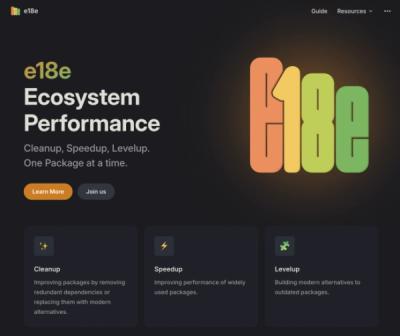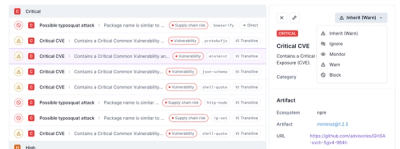
Research
Security News
Malicious npm Package Typosquats react-login-page to Deploy Keylogger
Socket researchers unpack a typosquatting package with malicious code that logs keystrokes and exfiltrates sensitive data to a remote server.
@aws-sdk/client-amplify
Advanced tools
Package description
@aws-sdk/client-amplify is a part of the AWS SDK for JavaScript, which allows developers to interact with AWS Amplify, a service for building and deploying mobile and web applications. This package provides methods to manage Amplify apps, branches, domains, and webhooks.
Create an Amplify App
This feature allows you to create a new Amplify app by specifying the app name, repository, and platform. The code sample demonstrates how to use the CreateAppCommand to create an app.
const { AmplifyClient, CreateAppCommand } = require('@aws-sdk/client-amplify');
const client = new AmplifyClient({ region: 'us-west-2' });
const createApp = async () => {
const params = {
name: 'MyAmplifyApp',
repository: 'https://github.com/my-repo',
platform: 'WEB'
};
const command = new CreateAppCommand(params);
const response = await client.send(command);
console.log(response);
};
createApp();List Amplify Apps
This feature allows you to list all the Amplify apps in your account. The code sample demonstrates how to use the ListAppsCommand to retrieve and print the list of apps.
const { AmplifyClient, ListAppsCommand } = require('@aws-sdk/client-amplify');
const client = new AmplifyClient({ region: 'us-west-2' });
const listApps = async () => {
const command = new ListAppsCommand({});
const response = await client.send(command);
console.log(response.apps);
};
listApps();Create a Branch
This feature allows you to create a new branch in an existing Amplify app. The code sample demonstrates how to use the CreateBranchCommand to create a branch.
const { AmplifyClient, CreateBranchCommand } = require('@aws-sdk/client-amplify');
const client = new AmplifyClient({ region: 'us-west-2' });
const createBranch = async () => {
const params = {
appId: 'd1e2f3g4h5',
branchName: 'new-feature-branch'
};
const command = new CreateBranchCommand(params);
const response = await client.send(command);
console.log(response);
};
createBranch();Delete an Amplify App
This feature allows you to delete an existing Amplify app. The code sample demonstrates how to use the DeleteAppCommand to delete an app by specifying its appId.
const { AmplifyClient, DeleteAppCommand } = require('@aws-sdk/client-amplify');
const client = new AmplifyClient({ region: 'us-west-2' });
const deleteApp = async () => {
const params = {
appId: 'd1e2f3g4h5'
};
const command = new DeleteAppCommand(params);
const response = await client.send(command);
console.log(response);
};
deleteApp();The aws-amplify package is a comprehensive library that provides a declarative interface for interacting with AWS services, including Amplify. It offers higher-level abstractions and is designed to be used in front-end applications, making it easier to integrate AWS services without deep knowledge of the underlying APIs.
The serverless package is a framework for building and deploying serverless applications on AWS and other cloud providers. While it is not specific to Amplify, it provides tools for managing AWS resources, including Lambda functions, API Gateway, and DynamoDB, which can be used in conjunction with Amplify for a full-stack serverless application.
The aws-cdk (AWS Cloud Development Kit) is a framework for defining cloud infrastructure using code. It allows you to define AWS resources using familiar programming languages like TypeScript, Python, and Java. While it is more focused on infrastructure as code, it can be used to define and manage Amplify resources as part of a larger infrastructure setup.
Changelog
3.568.0 (2024-05-02)
Readme
AWS SDK for JavaScript Amplify Client for Node.js, Browser and React Native.
Amplify enables developers to develop and deploy cloud-powered mobile and web apps. Amplify Hosting provides a continuous delivery and hosting service for web applications. For more information, see the Amplify Hosting User Guide. The Amplify Framework is a comprehensive set of SDKs, libraries, tools, and documentation for client app development. For more information, see the Amplify Framework.
To install the this package, simply type add or install @aws-sdk/client-amplify using your favorite package manager:
npm install @aws-sdk/client-amplifyyarn add @aws-sdk/client-amplifypnpm add @aws-sdk/client-amplifyThe AWS SDK is modulized by clients and commands.
To send a request, you only need to import the AmplifyClient and
the commands you need, for example ListAppsCommand:
// ES5 example
const { AmplifyClient, ListAppsCommand } = require("@aws-sdk/client-amplify");
// ES6+ example
import { AmplifyClient, ListAppsCommand } from "@aws-sdk/client-amplify";
To send a request, you:
send operation on client with command object as input.destroy() to close open connections.// a client can be shared by different commands.
const client = new AmplifyClient({ region: "REGION" });
const params = {
/** input parameters */
};
const command = new ListAppsCommand(params);
We recommend using await operator to wait for the promise returned by send operation as follows:
// async/await.
try {
const data = await client.send(command);
// process data.
} catch (error) {
// error handling.
} finally {
// finally.
}
Async-await is clean, concise, intuitive, easy to debug and has better error handling as compared to using Promise chains or callbacks.
You can also use Promise chaining to execute send operation.
client.send(command).then(
(data) => {
// process data.
},
(error) => {
// error handling.
}
);
Promises can also be called using .catch() and .finally() as follows:
client
.send(command)
.then((data) => {
// process data.
})
.catch((error) => {
// error handling.
})
.finally(() => {
// finally.
});
We do not recommend using callbacks because of callback hell, but they are supported by the send operation.
// callbacks.
client.send(command, (err, data) => {
// process err and data.
});
The client can also send requests using v2 compatible style. However, it results in a bigger bundle size and may be dropped in next major version. More details in the blog post on modular packages in AWS SDK for JavaScript
import * as AWS from "@aws-sdk/client-amplify";
const client = new AWS.Amplify({ region: "REGION" });
// async/await.
try {
const data = await client.listApps(params);
// process data.
} catch (error) {
// error handling.
}
// Promises.
client
.listApps(params)
.then((data) => {
// process data.
})
.catch((error) => {
// error handling.
});
// callbacks.
client.listApps(params, (err, data) => {
// process err and data.
});
When the service returns an exception, the error will include the exception information, as well as response metadata (e.g. request id).
try {
const data = await client.send(command);
// process data.
} catch (error) {
const { requestId, cfId, extendedRequestId } = error.$metadata;
console.log({ requestId, cfId, extendedRequestId });
/**
* The keys within exceptions are also parsed.
* You can access them by specifying exception names:
* if (error.name === 'SomeServiceException') {
* const value = error.specialKeyInException;
* }
*/
}
Please use these community resources for getting help. We use the GitHub issues for tracking bugs and feature requests, but have limited bandwidth to address them.
aws-sdk-js
on AWS Developer Blog.aws-sdk-js.To test your universal JavaScript code in Node.js, browser and react-native environments, visit our code samples repo.
This client code is generated automatically. Any modifications will be overwritten the next time the @aws-sdk/client-amplify package is updated.
To contribute to client you can check our generate clients scripts.
This SDK is distributed under the Apache License, Version 2.0, see LICENSE for more information.
FAQs
Unknown package
The npm package @aws-sdk/client-amplify receives a total of 180,959 weekly downloads. As such, @aws-sdk/client-amplify popularity was classified as popular.
We found that @aws-sdk/client-amplify demonstrated a healthy version release cadence and project activity because the last version was released less than a year ago. It has 5 open source maintainers collaborating on the project.
Did you know?

Socket for GitHub automatically highlights issues in each pull request and monitors the health of all your open source dependencies. Discover the contents of your packages and block harmful activity before you install or update your dependencies.

Research
Security News
Socket researchers unpack a typosquatting package with malicious code that logs keystrokes and exfiltrates sensitive data to a remote server.

Security News
The JavaScript community has launched the e18e initiative to improve ecosystem performance by cleaning up dependency trees, speeding up critical parts of the ecosystem, and documenting lighter alternatives to established tools.

Product
Socket now supports four distinct alert actions instead of the previous two, and alert triaging allows users to override the actions taken for all individual alerts.